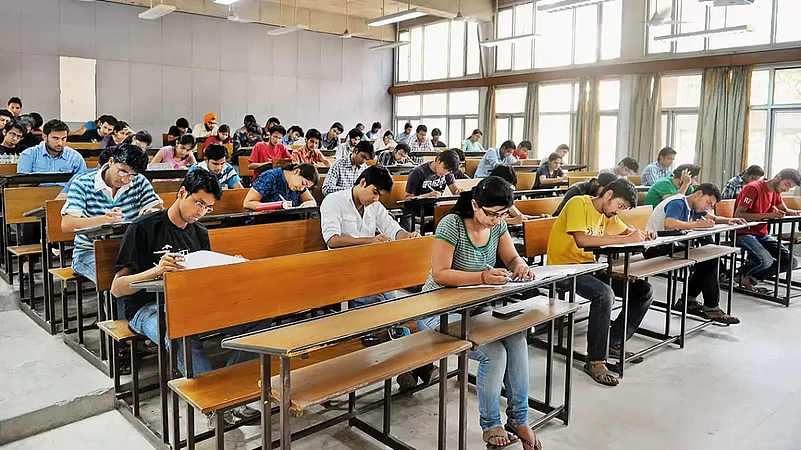India has a very large, relatively young, and rapidly expanding higher education (HE) system. More than two-thirds of the universities and colleges were founded in the twenty-first century. A few higher education institutions (HEIs) have a global reputation for research. Still, the focus and discourse of the HE system have primarily been on education, with research-focused universities needing to receive the attention they deserve. Consequently, despite having one of the largest higher education systems in the world, Indian universities are underrepresented in global rankings, primarily based on universities’ research capabilities and contributions.
Critical to the success of research universities in a country is the country’s overall higher education (HE) system. However, their success also depends on the larger ecosystem, including industries, professional organisations, and other stakeholders. The presence of a research and innovation-driven industry boosts research universities, as much of the applied research results in the delivery of products and services by businesses. Similarly, respectable professional organisations contribute significantly to research. These organisations frequently give awards, prestigious fellowships, etc., to recognise research achievements, which go a long way towards fostering research excellence, as the respect of peers often motivates researchers. Society also plays an important role: if researchers are highly regarded and a research career is valued, research universities will contribute to growth. While many factors play a significant role, the most essential support research universities require is from the higher education system as a whole.
A Differentiated System for Higher Education
Typically, a country’s overall higher education sector is much larger than the number of research universities. India’s higher education system is one of the largest in the world due to the massification of higher education over the past several decades. Any extensive higher education system will have to be differentiated; all universities in a system as comprehensive as India’s cannot be research universities. While education and research are the two primary goals of a university, not all universities must be research universities, nor can they be. A differentiated higher education system is required to meet educational needs while sustaining fewer research institutions. Without a differentiated approach, all universities would be treated identically, which would be counterproductive because research universities have a different ethos and purpose and must be supported and treated differently than universities that may emphasise education more.
Nurturing Knowledge: Fostering a Dynamic Three-Tier Research Environment
A natural way to organise the higher education system is to divide it into three tiers: the first tier focuses on research and doctorates, the second on postgraduate and undergraduate education, and the third on undergraduate education.
In such a three-tier system, the top (tier I) universities are the research universities, which, despite offering all levels of education, strongly emphasise research and conduct international research. They have robust Ph.D. programmes and are crucial to the national research ecosystem. Tier II universities emphasise Master’s and undergraduate education and may offer a modest Ph.D. programme. The primary purpose of these universities is to provide higher education. A high-quality education necessitates the incorporation of the most recent advancements; therefore, these universities will need a modest research and doctoral programme. Colleges primarily focus on undergraduate programmes at the third level (tier III), though they may also offer Master’s-level courses. Additionally, their programmes may be based more on an established body of knowledge.
A differentiated higher education system, such as the three-tier system, is required to maintain the accessibility of education while maintaining research universities. Tiers II and III play a crucial role in maintaining the accessibility of higher education because the cost of education is inevitably much higher at research universities than at teaching-focused universities and at teaching-focused universities than at colleges. Research universities cannot meet the total demand for higher education because the cost to students and society would be prohibitive. Only a tiny proportion of students receive an education in these research universities. In addition, acquiring faculty talent for many research universities is simply impossible.
The current higher education system in India consists of universities and colleges. This stratification is based on something other than educational objectives but on the authority to design education programmes and award degrees; universities have this authority, but colleges do not. Only a few of India’s roughly 1,200 universities conduct high-quality research and publish in reputable international journals, thus qualifying as research universities. The remainder focuses primarily on education. To have research universities that are on par with global research universities, it is necessary to identify and support them to attain international standards.
Exploring Frontiers: Empowering Research-Focused Faculty for Innovation
A research-oriented university must have research faculty. Globally, the majority of research faculty hold doctorates. Research universities are distinguished because most of their full-time faculty members hold a doctorate. Because a significant proportion of faculty at many universities in India do not have a Ph.D., the criteria stipulate that at least 75% of the faculty must hold doctorates for the institution to be considered a research university. For a research university, it is reasonable to expect that each faculty member will have an average of one full-time Ph.D. student working with them; hence the second condition. As India’s higher education system is rapidly expanding, with so many new universities established in the last two decades, it is preferable to include full-time Ph.D. students, who also represent an investment in research as they receive stipends.
Research universities should be expected to produce the majority of Ph.D.s. in the country. Only the top 50 universities in the United States have approximately half of the Ph.D.s. The ratio produced by its research universities (which account for less than ten percent of the total) likely exceeds ninety percent. In India, many Ph.D.s. are conferred by institutions other than research universities. Due to their superior research capabilities, research universities are the only ones capable of producing the highest quality Ph.D.s. in the country. Efforts should be made to ensure that most Ph.D.s. are conferred by these universities, with a small number conferred by other universities (which will eventually allow some of them to become research universities).
Attempting to transform every university into a research university is neither desirable nor feasible. While some universities in tier II can become research universities by improving their research appropriately over time, the remaining universities should continue to focus on education. Their mission should be to improve the quality of education at the Bachelor’s and Master’s levels and to keep their educational programmes in line with new knowledge emerging in various disciplines. By expecting universities of tier II to conduct excellent research, their focus needs to be more balanced, often resulting in mediocre research and education.
The NEP also envisions a three-tier system for Indian higher education. It is suggested that approximately 100 universities can be identified shortly to form the initial group of research universities, which can then be expanded into sizeable multidisciplinary research universities with between 5,000 and 25,000 students and a high number of Ph.D.s. awarded. Some universities from Tier II may ascend to Tier I over time, and the number of research universities may increase from 150 to 300. It proposes the abolition of the affiliating college model and the entire academic autonomy of all colleges, particularly in the course design, teaching, and evaluation processes.
Empowering Excellence: The Evolution of Research University Autonomy
In addition to teaching, research, and the third mission, research universities engage in numerous other activities. Their environment is unlike that of other organisations. In addition, they compete and collaborate globally with research universities worldwide. These universities can only be managed efficiently if they have complete operational autonomy (within the confines of the overall HE policies). If a country wants its research universities to compete internationally, it should grant these institutions as much autonomy as possible.
Autonomy implies that the university is responsible for all operational and administrative decisions. There are three levels of university management: the top-level governance body, which creates policies and oversees their implementation; leadership, which includes the chief executive; and management and administration. The autonomy of research universities in India must be strengthened at the first two levels, as autonomy at the management level is generally sufficient. Research indicates that universities with greater independence, accountability, and competition perform better.
Knowledge Nexus: Uniting Research Universities for Collective Advancement
India needs an organization of research universities at present. These universities face unique challenges, and a general association of Indian universities, which is open to all universities, cannot represent their views. This could result in the government and policymakers paying attention to pertinent issues facing research universities. For this association to be influential, its size should be kept small to function cohesively. It should be self-selecting, employing clear criteria for inviting new members to join and terminating existing memberships. Obviously, its membership and representation should be limited to select universities and completely independent from the government.
Fuelling Discovery: Unlocking Funding for Research Universities
For India’s top universities to be ranked among the world’s best, their research expenditures must increase significantly. For research universities to flourish, two types of research funding are required: Long-term block research funding, which is based on the university’s research performance, and Sponsored research project funding, which is granted based on research proposals.
Based on the evaluation of research contributions and impact, a five- to seven-year block grant is awarded. Universities must increase the quality and quantity of their research to obtain a larger slice of this funding pie. Additionally, they are allowed to demonstrate their worth and are rewarded accordingly every five years or so. This is an excellent model because it encourages performance; universities with superior performance receive more significant funding. This block grant also supports research in areas where grant funding may not be available, in addition to covering the overhead costs incurred by universities in the execution of research projects that are not fully covered by the typically small overhead costs provided in research grants.
The best method for universities to support sponsored research is to award competitive research grants to faculty based on research proposals. Each Indian agency’s extramural funding must be substantially increased to increase the research funding available to universities. Extramural funding can also facilitate increased collaboration between these agencies’ laboratories and university researchers. There are additional ways to increase R&D funding to universities, such as requiring government departments that can benefit from R&D to have a specific research budget for sponsored research.
Summing things up, few initiatives in the overall HE ecosystem that can help research universities thrive. These include having a differentiated HE system that can separate out research universities from the rest, providing a greater degree of autonomy to research universities so they can compete more effectively with their global counterparts who already enjoy much more autonomy, having special funding for research in research universities based on research performance, having an association for research universities that can voice a collective opinion of these universities, starting education programmes to professionalise university administrative functions, creating a few large multidisciplinary universities by expanding some existing ones and by merging some institutions together, and developing a few centres for higher education research that can critically examine issues relating to Indian HE and provide information for policymaking. In embracing these transformative initiatives, research universities can embark on a journey of unparalleled growth and excellence, revolutionizing the higher education ecosystem and elevating their impact on global knowledge advancement.
***
Methodology
Our ranking methodology evaluates Higher Education Institutions (HEIs) based on five core criteria: Academic and Research Excellence, Industry Interface and Placements, Infrastructure & Facilities, Governance & Admissions, and Diversity & Outreach. Each broad parameter is further broken down into sub-parameters and indicators, each carrying a specific weightage.
To ensure fairness and accuracy, we employ a multi-faceted data collection approach. We gather ranking data through comprehensive surveys involving various stakeholders, including students, faculty, and others associated with the HEIs. Additionally, we meticulously vet the data by cross-referencing it with evidence and reliable third-party sources.
In cases where direct data may be limited, we resort to trusted and authoritative sources like AISHE, NAAC, NIRF, etc., to supplement the information. This ensures that our ranking process maintains its integrity and impartiality.
The data we collect is normalised to standardise scores across different parameters. This normalisation enables a fair comparison of institutions, regardless of their size or other factors that could influence raw scores. After normalisation, the scores for each measure are weighted appropriately, culminating in a final overall score on a scale of 1000.
We take great pride in our methodology, which results from extensive research and continuous refinement. We remain committed to improving our approach by actively seeking user feedback, engaging in discussions with academic leaders and higher education experts, conducting literature reviews, and analysing trends in our data. Moreover, we stay vigilant about incorporating new and relevant data while collaborating with vice-chancellors, deans, researchers, academicians, and prominent educationists to stay at the forefront of developments in the education landscape.
With this comprehensive and evolving approach, our ranking system aims to provide a reliable and up-to-date assessment of Higher Education Institutions, empowering stakeholders to make informed decisions and fostering continuous growth in the academic community.
Dr Karthick Sridhar, Vice Chairman, ICARE

























